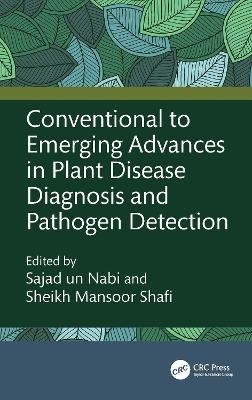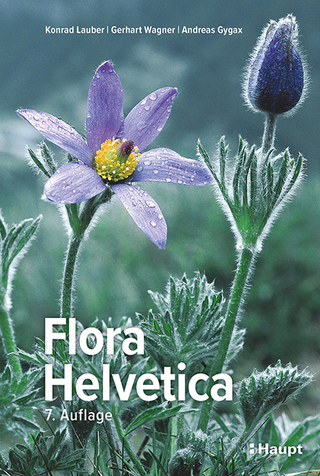
Conventional to Emerging Advances in Plant Disease Diagnosis and Pathogen Detection
CRC Press (Verlag)
978-1-032-75450-5 (ISBN)
- Noch nicht erschienen (ca. März 2025)
- Versandkostenfrei innerhalb Deutschlands
- Auch auf Rechnung
- Verfügbarkeit in der Filiale vor Ort prüfen
- Artikel merken
The chapters within this volume offer a comprehensive journey through the historical perspectives and groundbreaking innovations that have shaped disease diagnosis. We traverse the conventional methods that have laid the foundation for our understanding, and then embark on a journey through emerging technologies that promise to revolutionize the field. This compilation aims to connect traditional knowledge with the latest technological advancements, offering a comprehensive view of the trajectory of plant disease diagnosis. Created through collaborative efforts of field experts sharing insights and experiences, this resource is not only informative but also forward-thinking. Join us on this journey through the history, present, and future of plant disease diagnosis, driven by innovation and a collective dedication to safeguarding plant health and global agriculture.
Features
Comprehensive coverage of both traditional and contemporary diagnostic techniques for identifying plant diseases and detecting pathogens.
Detailed exploration of the latest advancements and innovations in disease diagnosis and pathogen detection, providing up-to-date knowledge.
In-depth discussion on cutting-edge diagnostic strategies, including artificial intelligence, machine learning, biosensors, next-generation sequencing, point-of-care assays, and CRISPR-Cas systems.
Abundantly illustrated with diagrams, flowcharts, and representations to support field identification and precise diagnosis of plant diseases.
Dr Sajad Un Nabi, (ARS, Ph.D), is working as scientist plant pathology at ICAR-Central institute of temperate horticulture Srinagar J&K, India. He completed his PhD in 2020 on apple viruses from ICAR-Indian Agricultural research institute, New Delhi India. He is a Life member of Indian Phytopathological Society, Indian Virological society, world society of virology and honorary life member of Asian PGPR Society. He has published more than 10.0 research publications including research papers, review papers, popular articles, books, book chapters, bulletins and pamphlets in nationally and internationally reputed journals and books. He has submitted more than 100 nucleotide sequences of plant pathogens to Genbank. He is the Recipient of IARI Gold Medal for outstanding academic performance in M.Sc degree, M.J.Narshiman medal from Indian Phytopathological Society for best paper, Young Achiever Award from Agricultural Technology Development Society, Excellence in Plant Pathology Award by International Association of Research and Development Organization (IARDO). He has identified the new potential vector “Hishimonus phycitis (Distant), for sesame phyllody phytoplasma in India, developed Trichoderma harzianum enriched vermicompost in the form of vermi balls and bars for management of soil borne diseases especially chilli wilt. He is presently working on apple cankers and temperate fruit viruses. He has identified new species Diplodia bulgarica in India associated with canker disease of apple. He first time characterized the species spectrum associated with apple canker disease in India. In temperate fruit viruses, he has identified new virus ApNMV and viroid AHVd associated with apple mosaic disease in India. He also confirmed the etiology of apple mosaic disease in India using RNA-Sequencing (RNA-Seq). He also developed multiplexing technique for simultaneous detection of four apple viruses viz., ApMV, ApNMV, ASPV and ASGV for indexing and production of quality virus free planting material. He has also optimized tissue and season for early and rapid detection of apple latent viruses viz., ASGV and ASPV. He is presently involved in understanding the mechanism of mosaic and necrosis development in apple using transcriptome analysis, Virome of stone fruits for developing easy diagnostics. He is also involved in developing scab resistant apple varieties for which two scab resistant apple hybrids has already been registered in NBPGR for national release. He is also involved in extension programmes on management of temperate fruit diseases by conducting trainings, TV talks and consultancies. Dr. Sheikh Mansoor currently serves as a postdoctoral researcher at the Phenomics Laboratory within Jeju National University in South Korea. His primary research focuses on high-throughput phenomics, remote sensing and precision agriculture. Prior to this role, he held positions as a Postdoc Research Associate at SKIMS Srinagar and as a Project Associate-I at CSIR-Indian Institute of Integrative Medicine Jammu (IIIM). Throughout his academic journey, Dr. Mansoor has had the opportunity to work in reputed laboratories, including the Transcriptomics Labs at SKUAST Kashmir and the Department of Biotechnology and Pathology at Central Institute of Temperate Horticulture (CITH) Rangreth Srinagar. His educational background comprises a BSc degree from SP College of Science (University of Kashmir), an MSc degree from HNBGU Uttarakhand, and a Ph.D. degree from Sher-e-Kashmir University of Agricultural Sciences and Technology of Jammu. Dr. Mansoor has been dedicated to contributing significantly to his field and has displayed a strong commitment to becoming a highly accomplished scientist. His expertise spans various areas, including biochemistry, molecular biology, and genetics. Dr. Mansoor's accomplishments are notable, including over more than 50 research and review papers published in esteemed journals such as Frontiers, Plos One, Scientific Reports, Journal of Fungi (JoF), Planta, Chemosphere, JEMA and Molecules etc. He has also authored 5 books and more than ten book chapters, and holds credit for filing two patent applications. He has showcased his knowledge through guest lectures on topics like sequence assembly, alignment, submission tools, and phylogenetic analysis. He has received practical training in advanced techniques in modern biology and related fields. Dr. Mansoor has been recognized with numerous national and international accolades, including prestigious awards such as Best Thesis, Young Scientist, and recognition for his exceptional oral and poster presentations. He holds membership in a significant big grant (BIRAC) awarded by the Department of Biotechnology (DBT) in India. In addition to his accomplishments, Dr. Mansoor plays an active role as a Review Editor for Frontiers in Ethnopharmacology, and he also contributes as a reviewer for esteemed journals like 3 Biotech, Cell Reports, Frontiers, Plos One, and JARMAP. His unwavering dedication, profound expertise, and active involvement underscore his unwavering commitment to advancing scientific knowledge in his field.
1 Plant Disease Diagnosis-Past, Present and Future
2 Microscopy as a tool for the detection of Plant Pathogens
3 Immunodiagnostics: From traditional to recent advances in plant virus detection
4 Molecular Diagnostics with a Special Focus on PCR-Based Approaches for The Detection of Plant Pathogens
5 Droplet Digital PCR in Fungal Pathogen Detection
6 Molecular PLANT-Dx System for Point-of-Use Detection of Pathogens associated with Plant disease
7 DNA Microarrays as a versatile tool for the detection of plant pathogens
8 Applications of robust isothermal amplification assays in the detection of fungal and viral plant pathogens
9 Next Generation Sequencing Approaches: Detection of Plant Pathogens with a Special Focus on Exploring Plant Virome
10 LabonChip Platform for field-based diagnosis of plant pathogens
11 Potential Use of Biosensors in Rapid Detection and Quantification of Pathogens Associated With Plant Disease
12 Applications of versatile CRISPR technology for the detection of targeted plant pathogen
13 High throughput phenomics and artificial intelligence in plant disease diagnosis
14 Artificial intelligence techniques in disease diagnosis
15 Applications of Nanotechnology for Rapid Detection of Plant Pathogens
| Erscheint lt. Verlag | 24.3.2025 |
|---|---|
| Zusatzinfo | 24 Tables, black and white; 30 Line drawings, black and white; 1 Halftones, black and white; 31 Illustrations, black and white |
| Verlagsort | London |
| Sprache | englisch |
| Maße | 156 x 234 mm |
| Themenwelt | Naturwissenschaften ► Biologie ► Botanik |
| Technik ► Umwelttechnik / Biotechnologie | |
| Weitere Fachgebiete ► Land- / Forstwirtschaft / Fischerei | |
| ISBN-10 | 1-032-75450-8 / 1032754508 |
| ISBN-13 | 978-1-032-75450-5 / 9781032754505 |
| Zustand | Neuware |
| Haben Sie eine Frage zum Produkt? |
aus dem Bereich


